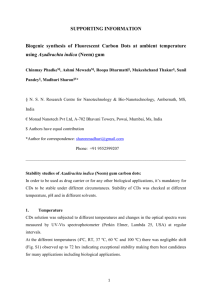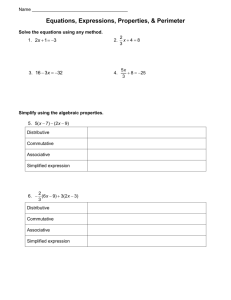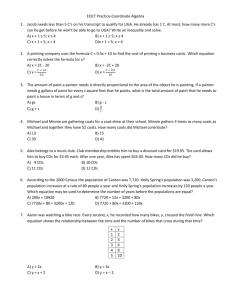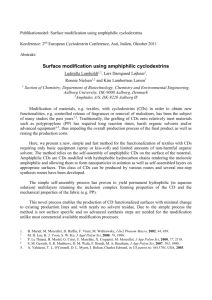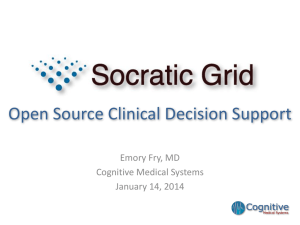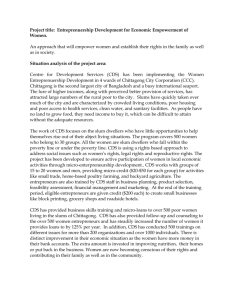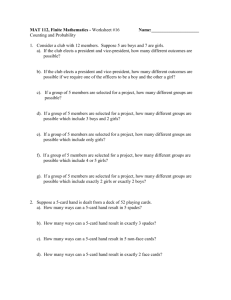CDS Intervention Format Workshop 4_11_12
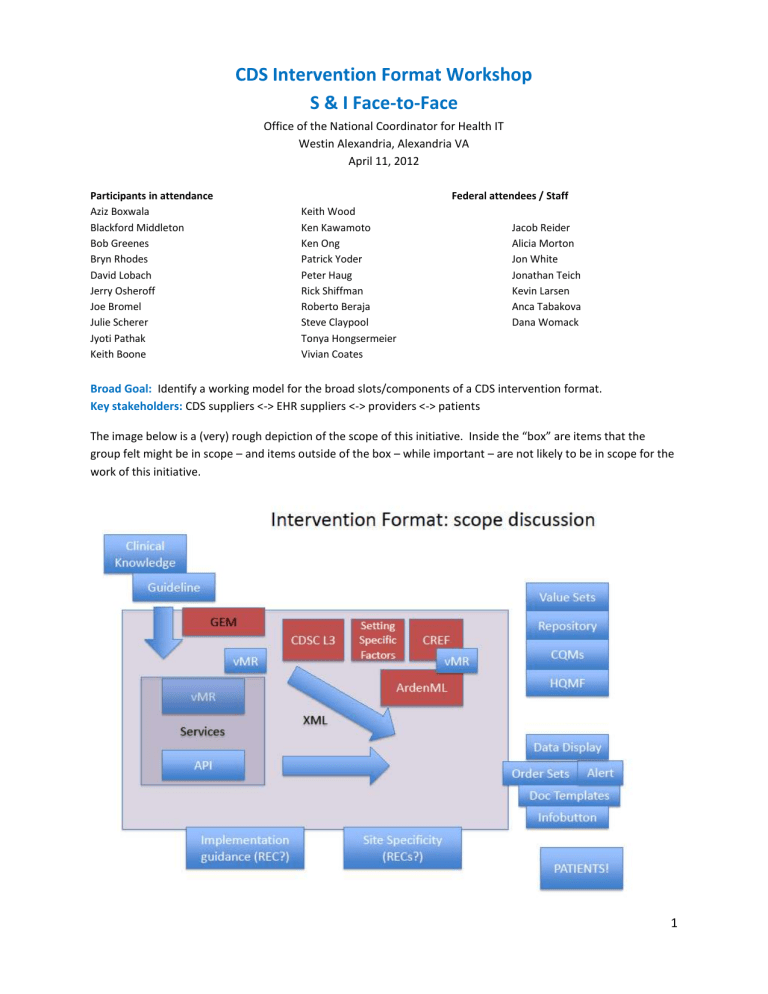
CDS Intervention Format Workshop
S & I Face-to-Face
Office of the National Coordinator for Health IT
Westin Alexandria, Alexandria VA
April 11, 2012
Participants in attendance
Aziz Boxwala
Blackford Middleton
Bob Greenes
Bryn Rhodes
David Lobach
Jerry Osheroff
Joe Bromel
Julie Scherer
Jyoti Pathak
Keith Boone
Keith Wood
Ken Kawamoto
Ken Ong
Patrick Yoder
Peter Haug
Rick Shiffman
Roberto Beraja
Steve Claypool
Tonya Hongsermeier
Vivian Coates
Federal attendees / Staff
Jacob Reider
Alicia Morton
Jon White
Jonathan Teich
Kevin Larsen
Anca Tabakova
Dana Womack
Broad Goal: Identify a working model for the broad slots/components of a CDS intervention format.
Key stakeholders: CDS suppliers <-> EHR suppliers <-> providers <-> patients
The image below is a (very) rough depiction of the scope of this initiative. Inside the “box” are items that the group felt might be in scope – and items outside of the box – while important – are not likely to be in scope for the work of this initiative.
1
Taking CDS to national scale: Key Facilitators
1.
Common Data representation. If facilities take responsibility for binding their data to a common representation (such as the vMR), then others can build knowledge representations to that common representation and deliver CDS as a service. o Standardize what goes in, what comes back out, and identify associated meta data so people can apply CDS locally o vMR simplifies data type definitions, is simpler than CCD for data expression, allows for creation of clinical statements for rule authoring, and templatized artifact authoring, which is helpful for tool development. o Local systems could be responsible for applying site-specific filters, or you can build a tool to allow hospitals to configure whether or not they have a CT scanner, or what’s in their formulary, etc.
2.
Common Knowledge representation. We need to establish a lingua franca for knowledge distribution, creating a one-to-many problem, rather than a many-to-many knowledge representation problem. o L3 – Layer 3 of the four layers identified by CDSC/ACDS (1 - Unstructured, 2 - Semi-structured, 3 -
Structured, and 4 – Executable) has been fleshed out across the 5 cardinal types of CDS interventions: alerts, info buttons, documentation templates/ smart forms, data display, order sets. o CREF format is computable - not pseudocode but is as human readable as possible, avoids need for a parser - at abstract syntax tree, limits need for parsing. o GEM is pseudocode – not computable. Represents clinical guidelines very well. Enforces clarity of guidelines. o Arden ML/SHARPC project 2B: XML representation of Arden Syntax. ArdenML is readily convertible to HL7-standard, Arden Syntax. It inherits the readability of that standard. Inclusion of VMR in SHARPC project avoids legacy “curly braces” problems with reference to standardized terminologies rather than local concepts. SHARPC also provides an ontology and template for incremental adaptation of generic rules to setting-specific rules, based on selection of Setting-
Specific Factors (SSFs).
3.
CDS as a service. Consuming a CDS service is easier and more cost effective for healthcare facilities than building & maintaining knowledge representation in local EHR applications. o Overextended community clinicians and acute care facilities do not have bandwidth to import, configure, maintain content. o CDS as a service also simplifies life for EHR vendors, as their primary responsibility would be to implement the outbound piece to send data to a service, and process what is returned back. o HL7 Decision Support Service (DSS) and Virtual Medical Record (vMR) standards exist and can be leveraged here for CDS services models.
Group Presentations:
CDSC/ACDS – Multilayered and multiple modality knowledge representation for enabling CDS, Aziz
Boxwala
Reliant Health – Operational Web Service-Based CDS, David Lobach
HL7 – vMR information model for CDS, Ken Kawamoto
Allscripts – Common Rule Engine Format (CREF), Bryn Rhodes
SHARP-C – Setting-Specific Factor (SSF)-Based Rule Modules expressed in ArdenML, Bob Greenes/Peter
Haug
2
GLIDES – Guideline Elements Model (GEM), Rick Shiffman
Summary of Group Discussion: CDS Intervention Components & Candidate Solutions
Components Candidate Standard Outstanding work
1.
Data Model
Lingua franca for pt. data
Data, instance, conditions
HL7 Virtual Medical Record (vMR) specification
( http://wiki.hl7.org/index.php
? title=Virtual_Medical_Record_
%28vMR%29#vMR_Specifications)
Ensure that vMR contains all required data elements for CDS.
2.
Knowledge Representation
Lingua franca for CDS logic
(Rules, interventions, actions)
Standard transport format that references standard value sets
GEM
CDSC L3
CREF
CDSC L3 and CREF
ArdenML with SSFs and incorporation of VMR
Specify expressions within L3 using
CREF for computable knowledge representation.
3.
CDS Services
Automated consumption
HL7 Decision Support Service standard and potentially other relevant CDS standards ( http://hsspdss.wikispaces.com/hl7_specification )
Specify additional service interfaces required to support CDS as a service. The HL7 CDS Work Group has started on this work
( http://ehrs4cds.wikispaces.com/ ).
4.
User Interface
5.
Governance
Standardization not required.
Vendors will implement the user interface layer and facilities will customize point-in-time presentation to localized workflows
N/A
Create a policy sandbox for CDS to identify the types of agreements that need to be in place for an organization to share CDS content or consume CDS services.
Additional Tools: Other standardized tools will be used further upstream (GEM – an ANSI standard, BRIDGE-Wiz – tool for guideline authors, mapped to HQMF, etc.
Relationship between CDS and Quality measurement:
CDS: People like Bob need a colonoscopy
3
CQM: Did Bob get a colonoscopy?
QM reporting: Bob Got One!
Relationship between Knowledge Representation and Ontologies:
Ontologies capture a level of medical knowledge representation that doesn’t happen elsewhere
While ontologies may not be in the XML, they are referred to in value sets. A national library of value sets that knowledge representation artifacts can reference is needed.
Meaningful Use considerations: o Define the most important problem/desired outcome and focus on this for certification criteria. o In MU 2 and 3, it will be important to establish a CDS floor, not a ceiling. For example, facilities with robust CDS capabilities that exceed that of a CDS service would not want to go backwards in functionality to meet MU requirements. o In stage 3, might see a knowledge vendor providing sets of things beyond the federal set of 20 or 30 that all vendors have.
Challenges:
Need to coalesce work already happening
Need support for experts to engage
Timeline for MU 3 is aggressive
Need stewardship of collaborative efforts
Like HIE: policy and governance are the hard parts
Easy way to integrate into a product
Possible initiative timeline:
2012
June: S&I kickoff
July/August: CDS intervention format agreement; SDO prep
Fall: Pilots well underway; SDO balloting
2013 +
Winter: Wrap up pilots; SDO Balloting complete (or May if 2 nd try necessary)
2014: Additional pilots if necessary/ production use
4

